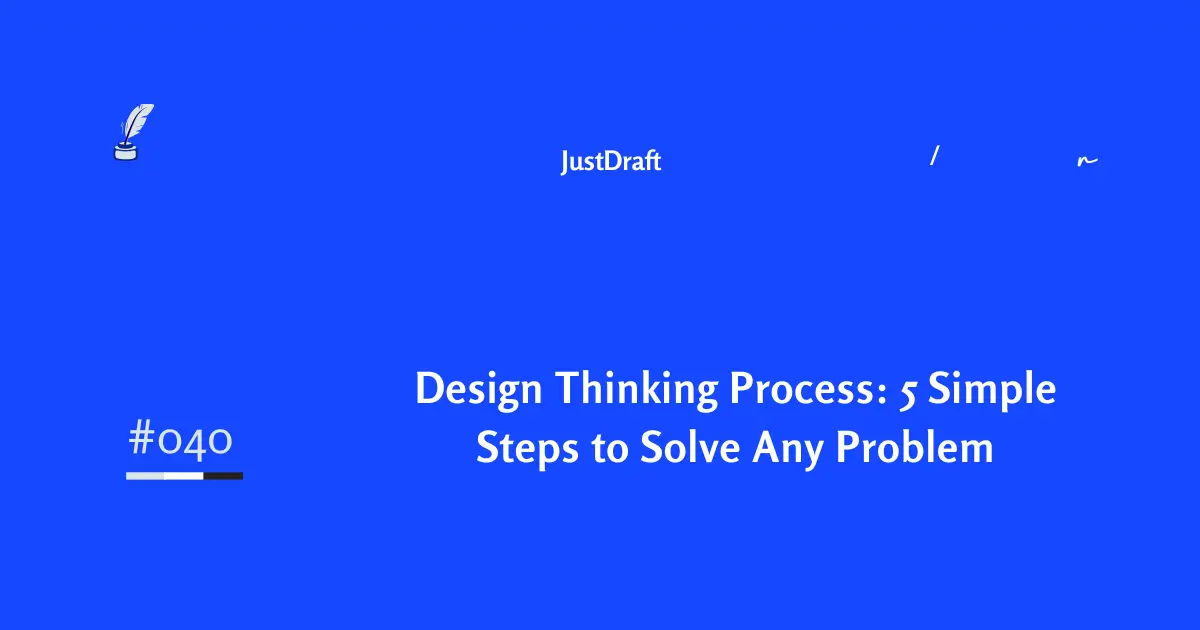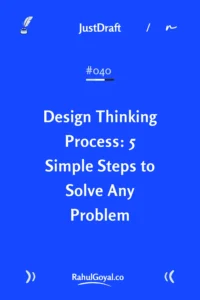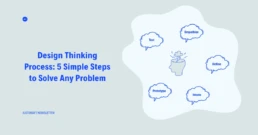The 5 Stages of the Design Thinking Process
Remember when Netflix almost went bankrupt in 2000? They had a brilliant idea – mail DVDs to customers. But here’s the thing: they didn’t just assume people wanted it. They spent months talking to frustrated Blockbuster customers, understanding their pain points, and testing different approaches.
That’s Design Thinking in action.
One Topic: Design Thinking Process
What Makes Design Thinking Different?
Most companies jump straight to solutions. “Our app needs more features!” or “We need better marketing!”
Design Thinking flips this. It starts with a simple question: “What do people actually need?”
It’s not about being creative for creativity’s sake. It’s about being methodical in how you solve problems.
The 5 Stages of Design Thinking Process That Change Everything
Stage 1: Empathise – Walk in Their Shoes
This isn’t about surveys or focus groups. It’s about real conversations.
A restaurant was chain losing that customers. Instead of guessing, the team spent a week sitting with frustrated diners, watching them struggle with long waits and confusing menus.
The insight? People didn’t want fancy food. They wanted predictability and speed.
Before solving any problem, spend time with the people experiencing it. Ask open-ended questions like “Tell me about your worst day with this process.”
Stage 2: Define – Frame the Real Problem
Here’s where most teams mess up. They define problems like “We need a better website” instead of “Busy parents need a faster way to order food because they’re juggling work and kids.”
The difference? One leads to random improvements. The other leads to breakthrough solutions.
Your move: Write your problem statement as “[Who] needs [what] because [why].” If you can’t fill in all three, you’re not ready for solutions.
Stage 3: Ideate – Generate Wild Ideas
Rules are simple:
- No judgment
- Quantity over quality
- Build on others’ ideas
- Get weird with it
That restaurant team? They came up with 47 ideas, including drive-through dining rooms and food delivery by drone. Most were terrible. But three were brilliant.
Action: Set a timer for 15 minutes. Write down every solution you can think of, no matter how crazy. The best ideas often hide behind the weird ones.
Stage 4: Prototype – Make It Real, Fast
Don’t build the perfect solution. Build the cheapest, fastest version that proves your point.
The restaurant team didn’t renovate their entire space. They created a cardboard mockup of a new ordering system and tested it with paper menus.
Cost? $20. Learning? Priceless.
So, use whatever you have. Cardboard, sticky notes, free apps. The goal isn’t pretty – it’s functional.
Stage 5: Test – Learn and Iterate
Put your prototype in front of real people. Watch what they do, not what they say.
The restaurant’s cardboard system failed spectacularly. Customers were confused. But that failure led to insights that created their successful mobile ordering system.
Test with 3-5 people. Don’t explain how it works – just watch. Their confusion is your next breakthrough.
Why Design Thinking Process Actually Works
Design Thinking works because it’s backwards from how most people solve problems.
Instead of assuming what people want, you discover it. Instead of building perfect solutions, you build testable ones. Instead of launching and hoping, you learn and iterate.
The result? Solutions people actually use.
Design Thinking isn’t just for designers. It’s for anyone who wants to solve problems that matter.
Try Design Thinking Your Life This Weekend
Pick one frustrating process in your work or life. Spend 30 minutes talking to someone else who deals with it. Ask them about their worst experience with it.
That’s your empathy stage. The other four stages can wait until next week.
Read last week’s JustDraft newsletter about The 7-Letter Formula for Creative Thinking.
Interested in travel, Read last week’s LensLetter about Use of Foreground to Create Depth in Your Images.

Two Quotes to Inspire
Design is not just what it looks like. Design is how it works.
Fall in love with the problem, not your solution.
One Passage From My Bookshelf
The fundamental activity of a startup is to turn ideas into products, measure how customers respond, and then learn whether to pivot or persevere. All successful startup processes should be geared to accelerate that feedback loop. This is the essence of the Lean Startup methodology. It is not about building a better mousetrap; it is about understanding the fundamental problem customers are trying to solve and then building a solution that addresses that problem in a way that customers will actually use. The goal is not to ship a product; the goal is to learn what customers really want and will pay for. This requires getting out of the building and talking to customers, not just assuming what they want. The biggest waste in startups is building something nobody wants. The way to avoid this waste is to test your hypotheses about what customers want before you build the full product. This is why the Build-Measure-Learn loop is so important. It helps you avoid building something that nobody wants by testing your assumptions early and often.
📚 From “The Lean Startup” by Eric Ries


